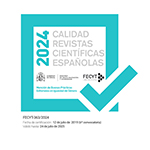The construction of enlightened honour and its imprint on Modernity’s hegemonic masculinity
Abstract
Introduction. The hegemonic masculinity, understood as a normative patriarchal construction, is an element built and maintained through certain interconnected features which are deeply rooted on History and the societies of the past. It is a complex ideological framework which has recently acquired a great importance, not only in academic research, but also in contemporary society. This fact has motivated its inclusion and use through different approaches and discourses, sometimes incorrectly applied. Objectives. With the purpose of examining this socialising procedure of men in a patriarchal context, the objective of this research is to analyse one of the most remarkable elements by which it is formed: The honour and its relationship with power and violence. In the following pages, it will be described how this concept is transformed with the emergence of The Enlightenment and its later establishment on the new modern paradigm. Methodology. To achieve this objective, it will be provided a critical reading not only of the bibliographical production made from historical approaches, but also from another anthropological and sociologic points of view. This reading, which is expected to establish the methodological basis and the theoretical framework created about this field of knowledge, it is supported by a critical analysis of Eighteenth-Century sources especially focused on those educative and public-opinion aspects spread by the press of this period. Results and conclusions. This analysis shows how the transformation and extension of the social honour are closely related with the socialization of the “perfect men”, which is settled from the Age of Reason and finds its representation throughout Modernity towards the present.
Downloads
Article download
License
In order to support the global exchange of knowledge, the journal Investigaciones Feministas is allowing unrestricted access to its content as from its publication in this electronic edition, and as such it is an open-access journal. The originals published in this journal are the property of the Complutense University of Madrid and any reproduction thereof in full or in part must cite the source. All content is distributed under a Creative Commons Attribution 4.0 use and distribution licence (CC BY 4.0). This circumstance must be expressly stated in these terms where necessary. You can view the summary and the complete legal text of the licence.











